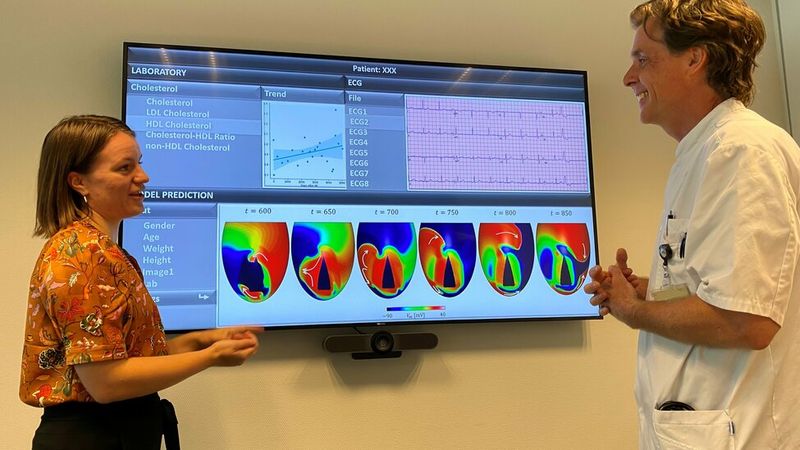Digital twins will help to tailor healthcare more in the future
Researchers Lukas Dekker and Carlijn Buck of TU/e and the Catharina Hospital are investigating how they can provide better-tailored care to heart patients through smart modeling, thanks to a digital twin of each patient.

Lukas Dekker and Carlijn Buck in consultation with their digital twin. Photo: Catharina Ziekenhuis Eindhoven
This article was first published on
www.tue.nlImagine you have a virtual copy of your own body. This digital twin, an accurate computer model, can help doctors better understand your health, personalize treatments, and intervene earlier to prevent more significant problems. What sounds like science fiction now is becoming more and more of a reality, and in the (distant) future, it could revolutionize healthcare.
Source: Catharina Ziekenhuis Eindhoven / Geert Piek
A digital twin is actually a kind of digital version of yourself, based on data from your body, but also on information from many other people. This technology is already being used in sectors such as industry and urban planning, where these virtual copies can be used to predict how machines or traffic systems will behave, for example.
Now, this technique is also increasingly finding its way into healthcare.
What does this mean for the patient of the future?
Lukas Dekker, cardiologist-electrophysiologist at the Catharina Hospital and professor at Eindhoven University of Technology (TU/e), explains: “In the future, we will be able to provide tailor-made care with the help of a digital twin.”
“This means that we are better able to determine the best treatment for each patient, instead of giving everyone the same standard of care. This not only makes healthcare more personalized but also more efficient and affordable. We move away from the idea of one size fits all.”
A digital twin is not a simple model that doctors use to try out surgeries in advance but a smart collection of data that uses real-time information to simulate and predict your health. “We combine medical scans, data on how your body moves and how it responds to treatments. This allows us to calculate, for example, how your heart functions,” says Dekker.
Saving lives
This opens the door to new possibilities. Let's say you've had a heart attack. With a digital twin, doctors would be able to predict who has an increased risk of cardiac arrhythmias after such an attack. That can save lives.
Carlijn Buck, PhD candidate in cardiovascular biomechanics, is working on the development of digital twins of heart patients within the COMBAT-VT project. “It's still a long way off to make a complete digital copy of the body, but the first versions of digital twins of the heart have already been created,” she says. “The next step is for such a model to adapt as new data comes in, and then quickly predict whether something will go wrong.”
This means that doctors can predict your health better and better without you having to go to the hospital constantly. “In the future, more and more devices you wear – such as smart watches or heart monitors – will pass on data to your doctor.”
“They can then monitor your health remotely and intervene if necessary,” explains Dekker. “When something is measured, you don't just want the data in question to be analyzed, but also to be analyzed in a certain context. After all, one person differs significantly from another, whether that is due to age, weight, or medical history.”
No unnecessary burden on healthcare
One of the most significant advantages of a digital twin is that it helps doctors estimate when you need what type of medical care. “Some patients may need to be checked more quickly than others. With a digital twin, we can better assess this in the future and offer tailored care,” says Dekker.
This also means that the healthcare system is not unnecessarily burdened. “Not every patient needs a complicated model,” Buck explains. “For some patients, a simple risk model is sufficient, based on data such as age and weight. But if there is a high risk, we can create a more detailed model to get a better understanding.”
She explains that this requires more complicated data, such as an MRI scan of the heart. This means more impact for the patient, a more labor-intensive job for the medical engineer who assembles the twin, and higher healthcare costs. “So if you don't need such a detailed model, you shouldn't do it.”
Human side remains crucial
Creating a digital twin is an intensive process in which technicians and doctors work closely together. The technician builds the twins while the doctor determines how they will be used in practice. “For example, in the case of ablation, a procedure to treat cardiac arrhythmias, the model could help determine when and how the heart can best be treated,” says Buck.
But, she emphasizes, a digital twin does not replace the doctor. “The model doesn't tell you how you feel or how you view surgery. It can't take the context into account; it's only useful for what it's made for. It is, therefore, a tool for the doctor to provide the best possible care. The human side and the overall context remain crucial, and that’s why we will still need a doctor.”
Enormous possibilities
Although the technology is still in the early stages of development, the possibilities of digital twins are enormous. The combination of data, technology and medical expertise ensures that we can provide more and more tailor-made care in the future.
The COMBAT-VT project falls under the umbrella of the Eindhoven MedTech Innovation Center (e/MTIC), a large regional partnership in the field of medical technology between TU/e, Philips, and the Catharina Hospital, Maxima Medical Center, and Kempenhaeghe. A crucial collaboration for this research is combining input from healthcare with technological developments.